#choerodon
Explore tagged Tumblr posts
Text

Harlequin Tuskfish (Choerodon fasciatus), family Labridae, order Labriformes, Great Barrier Reef, Cairns, Australia
photograph by Leonard Low
327 notes
·
View notes
Text
Round 2 - Chordata - Actinopterygii
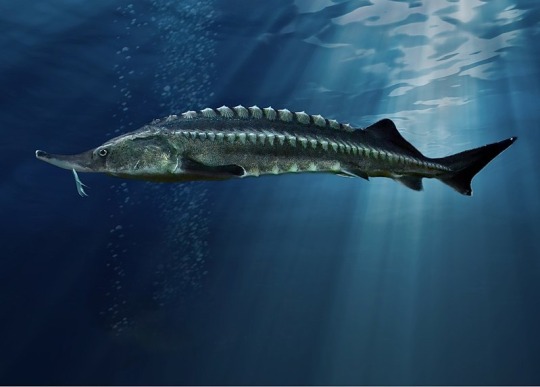
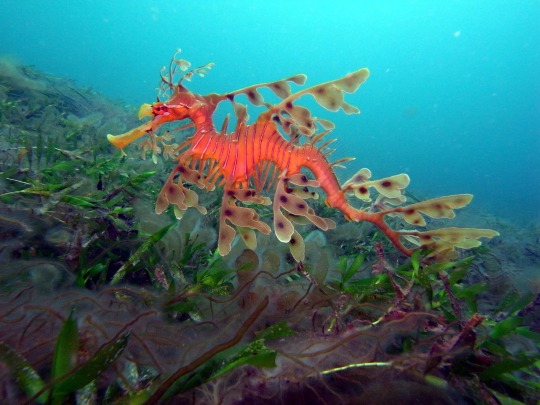

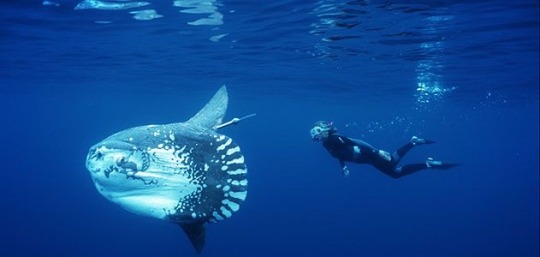
(Sources - 1, 2, 3, 4)
Over 50% of chordate species are Actinopterygians (“Ray-finned Fishes”). There are over 30,000 species, comprised of the Polypteriformes (“Bichirs” and “Reedfish”), Acipenseriformes (“Sturgeons” and “Paddlefish”), Amiiformes (“Bowfins”), Lepisosteiformes (“Gar”), and the Teleosts (about 40 orders containing all rest of the actinopterygians).
Ray-finned Fishes are so called because of their lightly built fins made of skin webbings supported by thin bony spines. Actinopterygians are unique for their swim bladder, an organ that allows them to adjust their buoyancy. They are the most abundant free-swimming aquatic animals and can be found almost anywhere there is water. They come in a vast majority of sizes, shapes, scale-types, fin-arrangements, colors, and behaviors, from the 8 mm (0.3 in) long Paedocypris to the 11 m (36 ft) long Giant Oarfish (Regalecus glesne) to the 2,744 kg (6,049 lb) Giant Sunfish (Mola alexandrini). They have feeding strategies ranging from predatory to grazing to filter-feeding.
In most actinopterygians, males and females exist and reproduce through external fertilization. However, some species utilize sequential hermaphroditism, in which they start life as females and convert to males at some point. In a few species, they start life as males and convert to females. Some species give live birth, and some species self-fertilise. Some abandon their young, while some practice maternal and/or even paternal care.
The earliest known actinopterygian is Andreolepis hedei, from the Late Silurian. The teleosts in particular diversified wildly during the Mesozoic, resulting in the high diversity of shapes we see today. The earliest fossil relatives of modern teleosts, (Prohalecites and Pholidophorus), are from the Triassic period, though it is suspected that teleosts originated already during the Paleozoic Era.
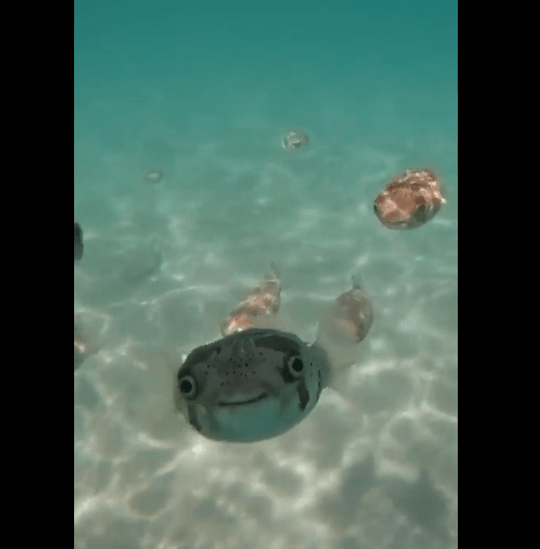
Propaganda under the cut:
Many Actinopterygians, especially those that live in the deep sea, are bioluminescent, glowing in a variety of colors and patterns to attract prey, mates, or even just communicate.
Some species of Puffer Fish (Family Tetrapdontidae) are highly poisonous, second only among vertebrates to the Golden Dart Frog (Phyllobates terribilis).
The most venomous fish is the Reef Stonefish (Synanceia verrucosa). The spines on its back produce a venom which can cause severe pain, shock, paralysis, and tissue death in humans.
Male Seahorses (Genus Hippocampus) are known for having a pouch in which they carry eggs laid by the female.
The Harlequin Tuskfish (Choerodon fasciatus) has electric blue vampire teeth.
Speaking of teeth, Serrasalmids have jaws ranging from human-looking nutcracker teeth to bear-trap looking flesh-eating chompers.
The Mandarinfish (Synchiropus splendidus) and the Picturesque Dragonet (Synchiropus picturatus) are the only two vertebrate species known to produce their own true blue coloring. Blue as a color is usually a result of reflected light, and almost all cells that are perceived as blue are actually a reflective black. However, these two mandarinfish species have cyanophores, which are both blue in pigment and reflective, making them the most blue animals in nature.
Many fish are popular in the pet trade (some more ethical pets than others) and some have even been domesticated and bred to display a variety of colors and shapes, including goldfish, koi, Betta, and zebrafish.
Moray Eels (family Muraenidae) have a hidden set of internal jaws, called pharyngeal jaws. While most predatory fish use suction to “inhale” their prey, moray eels just… pull them in.
The Mangrove Rivulus (Kryptolebias marmoratus), a species of killifish, mostly breeds by self-fertilization and can survive for about two months on land. Males are rare, and can only hatch from eggs kept below 19 °C (66 °F).
The most famous pupfish (family Cyprinodontidae, also a type of killifish) is probably the Devils Hole Pupfish (Cyprinodon diabolis). It is a critically endangered species found only in Devil’s Hole, a water-filled cavern in the US state of Nevada. When nearby agricultural irrigation caused the water to drop in the cavern, several court cases ensued, resulting in Devils Hole being declared a National Monument in 1952, including the preservation of adequate groundwater to maintain the pool. As of September 2022, the count showed a total of 263 observed wild pupfish, up from only 35 in 2013.
There are waaaay too many cool fish for me to write about; I keep thinking of cool facts but this is already getting so long and I gotta save some for if this class makes it to the next round 🥲
103 notes
·
View notes
Note

I give you...my favorite fish!
Harlequin Tuskfish -- Choerodon Fasciatus.
Oooh colorful little guy
22 notes
·
View notes
Text
HEROES SPIRIT LINKS AS FISH IF HEROES SPIRIT WERE FISH
This is my mermay contribution. All characters belong to @heroesspirit!!!
Each Link has a different place in the world of cultural inspiration, so at least one of the fish included for each is endemic to that region. Endemic means it is native to that specific area and not found (naturally) anywhere else in the world!! It’s really cool. There are some fish that are endemic to a singular lake!!!! Big lakes, but still one singular lake!!!! Or one reach of a tributary stream!!! It’s super cool.
Anyway. FISH!!!!! Image descriptions at the very bottom! :D
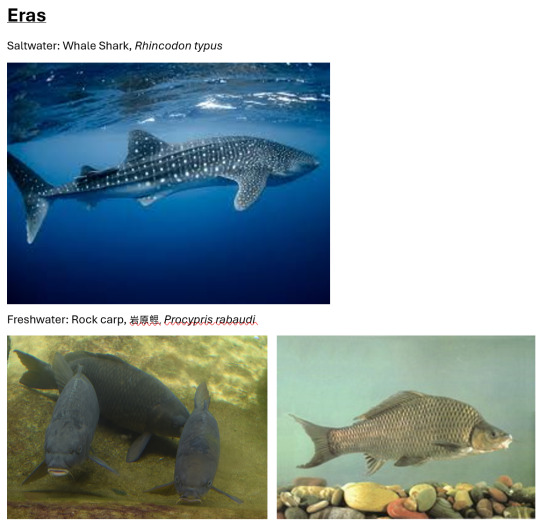
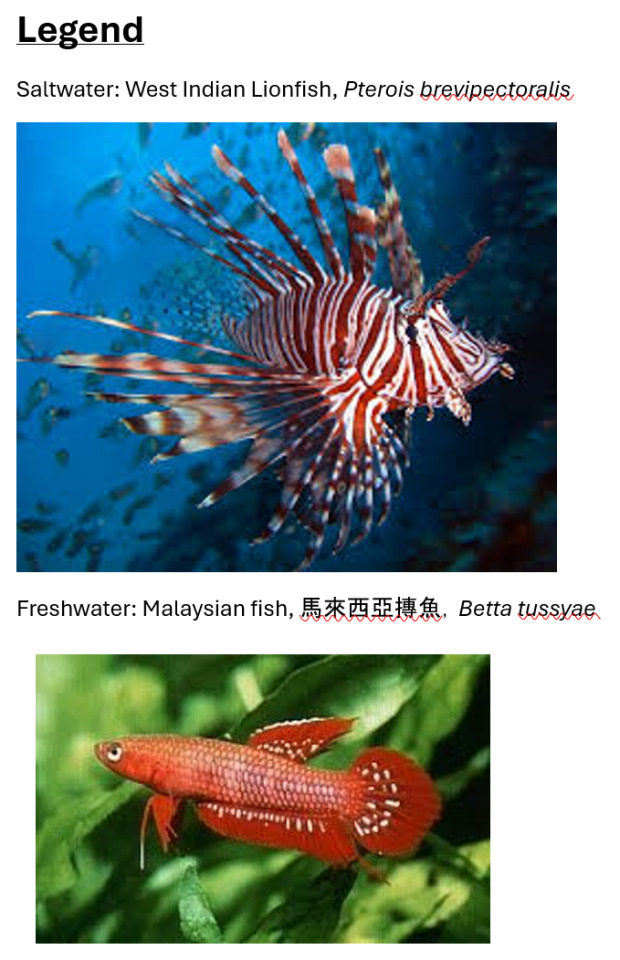
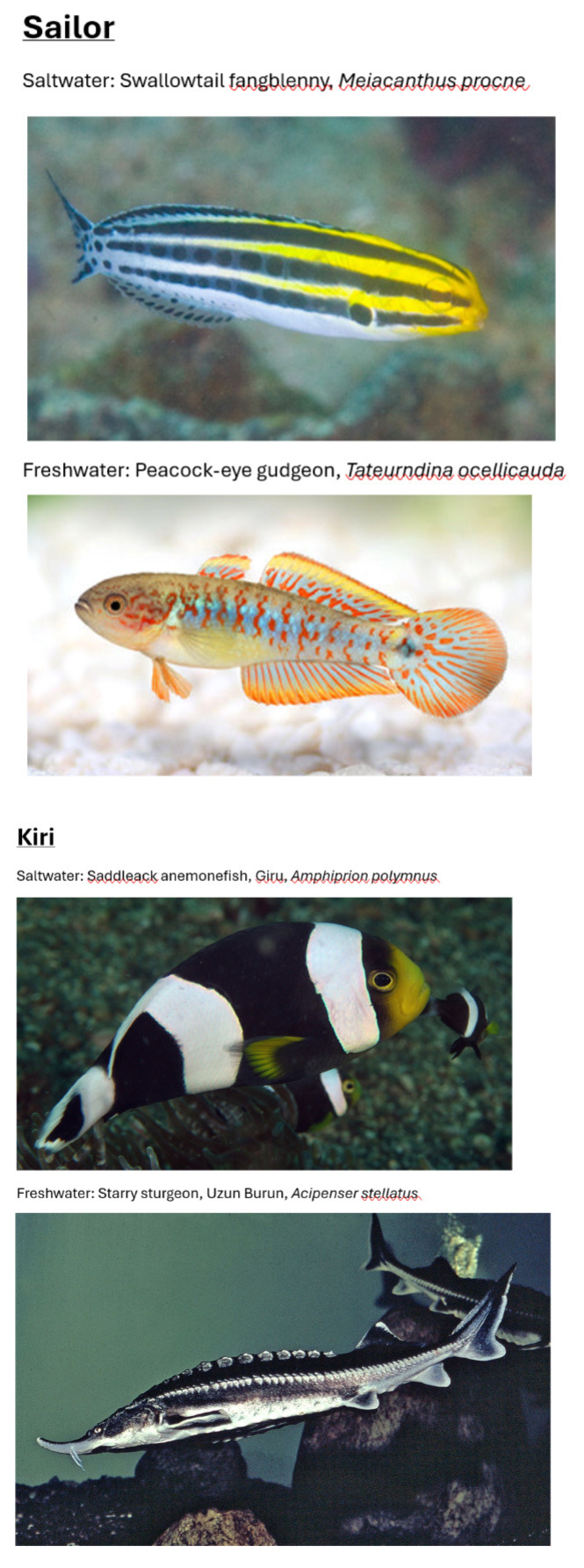

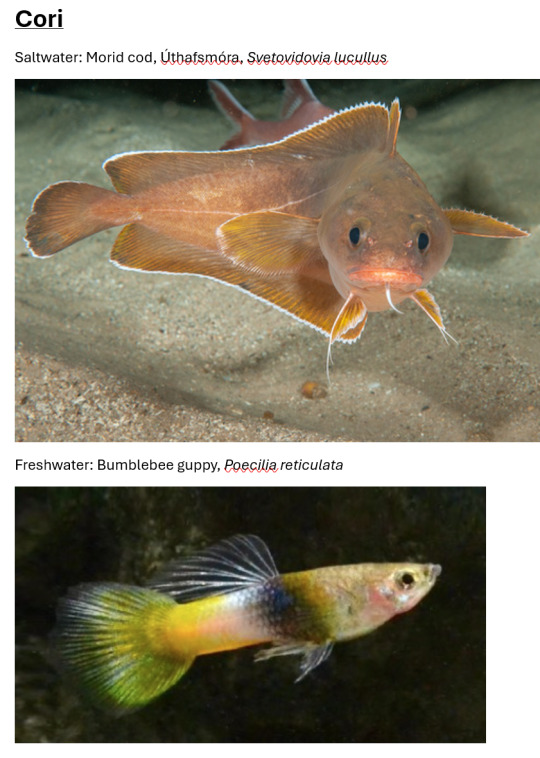
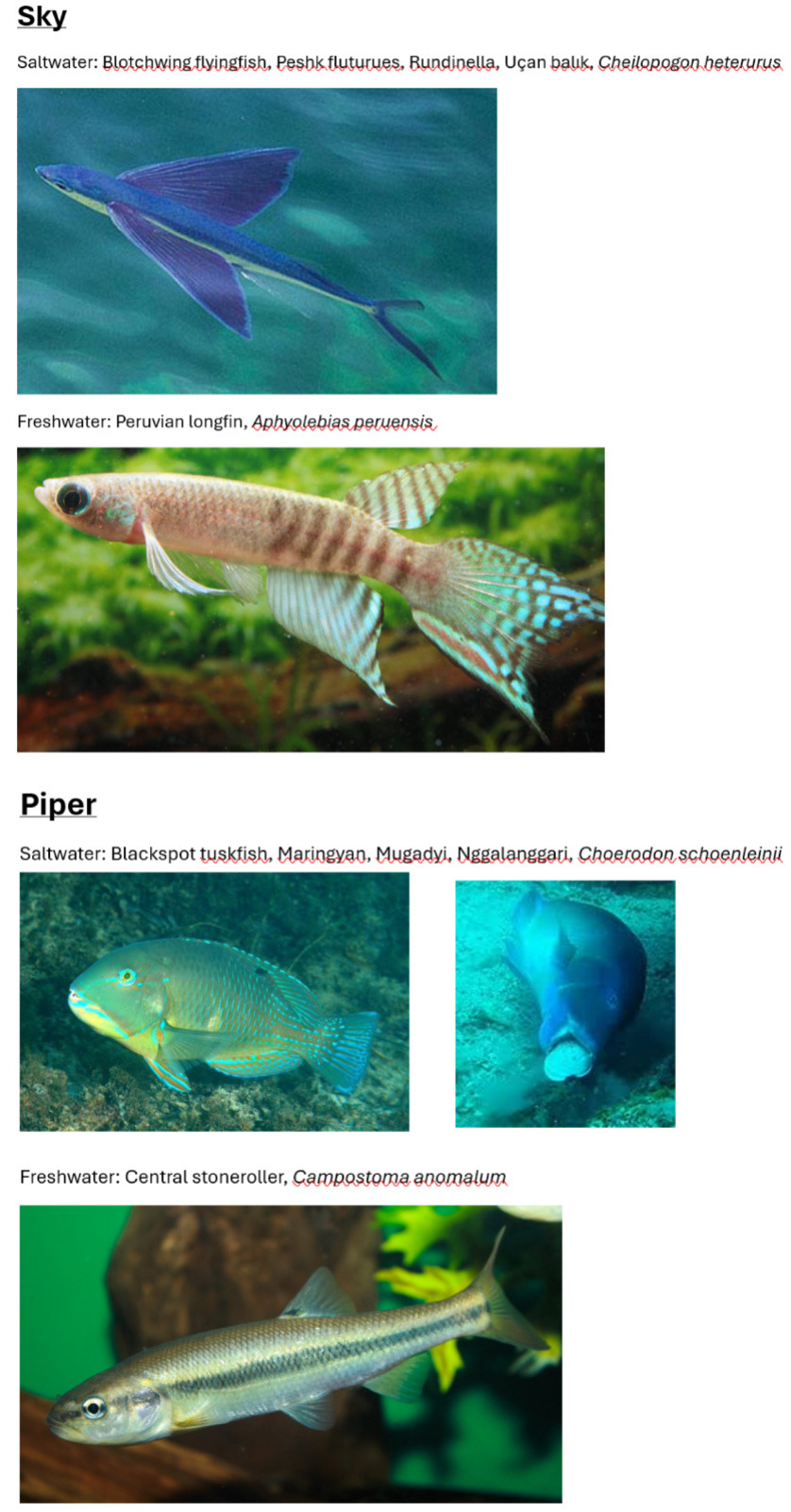
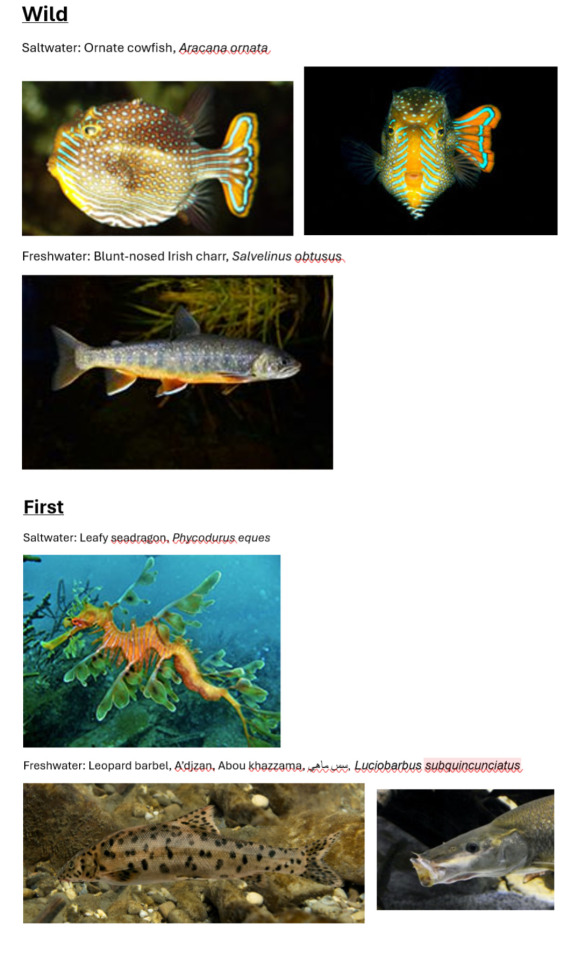
IMAGE ID: Images are the names of each link and then a saltwater fish and a freshwater fish. Each fish has the common name, the common name in the native language of wherever it is found, and then the scientific name. The fish are listed below. Since I am posting this on mobile I only have an English keyboard, so I am only including the common names in the ISO Latin alphabet in the descriptions.
Eras. Saltwater: Whale shark, Rhincodon typus. Freshwater: Rock carp, Procypris rabaudi.
Legend. Saltwater: West Indian lionfish, Pterois brevipectoralis. Freshwater: Malaysian fish, Betta tussyae.
Sailor. Swallowtail fangblenny, Meiacanthus procne. Freshwater: Peacock-eye gudgeon, Tateurndina ocellicauda.
Kiri. Saltwater: Saddleback anemonefish, Giru, Amphiprion polymnus. Freshwater: Starry sturgeon, Uzun burun, Acipenser stellatus.
Four. Saltwater: Bluehead fairy wrasse, Cirrhilabrus cyanopleura. Freshwater: Pumpkinseed sunfish, Zonnebaars, Lepomis gibbosus.
Cori. Saltwater: Morid cod, Úthafsmóra, Svetovidovia lucullus. Freshwater: Bumblebee guppy, Poecilia reticulata.
Sky. Saltwater: Blotchwing flyingfish, Peshk fluturues, Rundinella, Uçan balik, Cheilopogon heterurus. Freshwater: Peruvian longfin, Aphyolebias peruensis.
Piper: Blackspot tuskfish, Marigyan, Mugadyi, Nggalanggari, Choerodon schoeleinii. Freshwater: Central stoneroller, Campostoma anomalum.
Wild. Saltwater: Ornate cowfish, Arcana ornata. Freshwater: Blunt-nosed Irish charr, Salvelinus obtusus.
First: Saltwater: Leafy seadragon, Phycodurus eques. Freshwater: Leopard barbel, A’djzan, Abou khazzama, Luciobarbus subquincunciatus
/END ID
28 notes
·
View notes
Text
day 103, 06/05/24 - fish of the day is the harlequin tuskfish (Choerodon fasciatus)

5 notes
·
View notes
Text
Animal Crossing Fish - Explained #233
Brought to you by a marine biologist who uses tools to get shit done...
CLICK HERE FOR THE AC FISH EXPLAINED MASTERPOST!
If you're familiar with the debate surrounding animal intelligence, you've probably heard about the many tests animals can be given to test their level of intelligence. These tests are how we have determined that dolphins and great apes are smart as hell while most other animals really aren't. Now, we don't have a lot of time to talk about intelligence, but please understand that intelligence, like any trait, is useful for some but not for others, and that doesn't make those others lesser. Anyway, one test for intelligence is the use of tools, and today's fish - the Blackspot Tuskfish - was the first fish discovered to do just that.
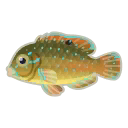
The Blackspot Tuskfish (acronym from now on - BSTF) appeared for a short while in Animal Crossing Pocket Camp for their Fishing Tourney #53, the Oasis Patio. This event occurred during August 2022, and the BSTF hasn't been seen since.
The BSTF is a species of wrasse belonging to Order Labriformes which includes the wrasses, parrotfish, and cales. These fish are most often associated with coral reef habitats and feed on a variety of organisms and algae, depending on species. Within Labriformes is Family Labridae which are the wrasses specifically. They are known to be incredibly colorful, and most are protogynous hermaphrodites, meaning they begin life as females and become male as they grow larger. Some, like the tuskfish (Genus Choerodon), have large, sharp teeth - "tusks" - and powerful jaws they use to crunch on bivalves and other hard prey. The BSTF (Choerodon schoenleinii) is a native to Indo-Pacific near-shore coral reefs, from East Africa out to various Pacific islands, where it does just that.

From https://fishesofaustralia.net.au/home/species/1928
When the BSTF finds a bivalve is just can't crack with its jaws alone, it goes looking for something to help it, like a rock it can smash the bivalve into. In July 2011, this behavior was finally documented, providing evidence to support the notion that wild fish can use tools. At least for BSTF, it was given that seal of approval, as using the rock to help it feed fit the accepted definition of tool use.
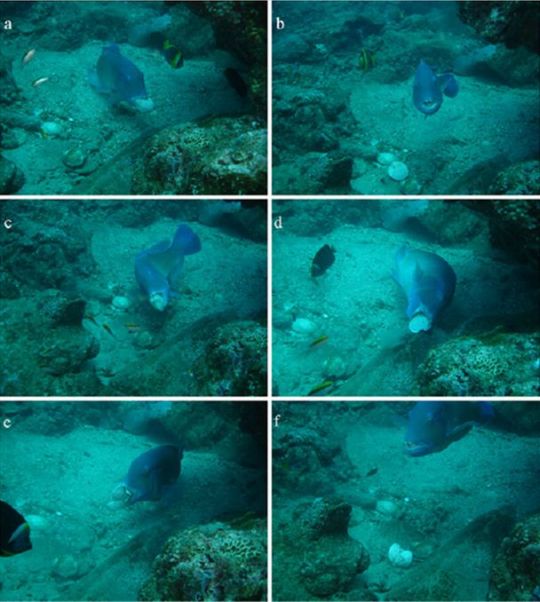
From https://phys.org/news/2011-07-photo-fish-tools.html
Fish are smarter than people give them credit for. At the end of the day, it's really hard to determine how smart a creature like a fish, that has evolved over millennia in an environment so unlike ours, is. We can't simply compare their intelligence to ours, nor should we snub our noses at animals that just don't have it. You wouldn't like it if a fish judged you based on how well you could breathe underwater.
And there you have it! Fascinating stuff, no?
#blackspot tuskfish#fish#animal crossing#animal crossing pocket camp#acpc#animals#marine biology#ocean#science#science in video games#animal crossing fish explained
4 notes
·
View notes
Text
Harlequin Tuskfish: A Fascinating Creature of the Sea
In the vibrant tapestry of marine life, the Harlequin Tuskfish (Choerodon fasciatus) stands out as a mesmerizing symbol of elegance and intrigue. With its striking colors and enigmatic behavior, this fish captivates marine enthusiasts and scientists alike. Found in the Indo-Pacific region, the Harlequin Tuskfish inhabits coral reefs, where it plays a vital role in maintaining ecological balance.…

View On WordPress
0 notes
Text
UltraMarine Magazine 89 è dedicato al labride Choerodon fasciatus
UltraMarine Magazine 89 è dedicato al labride Choerodon fasciatus - UltraMarine Magazine 89 è disponibile sul sito di UltraMarine per essere scaricato e letto. Tanti nuovi articoli per coinvolgerci. Vediamoli in dettaglio.
Un nuovo articolo su http://www.danireef.com/2021/10/14/ultramarine-magazine-89-e-dedicato-al-labride-choerodon-fasciatus/
UltraMarine Magazine 89 è dedicato al labride Choerodon fasciatus
#ChoerodonFasciatus, #Edicola, #Ultramarine
- by Danilo Ronchi
0 notes
Photo

Harlequin tuskfish (Choerodon fasciatus)
The harlequin tuskfish is a species of wrasse native to the western Pacific Ocean. It grows to a length of 30 cm. The harlequin tuskfish is a carnivore, eating mostly benthic invertebrates such as echinoderms, crustaceans, molluscs, and worms. This species inhabits reefs at depths from 5 to 35 m.
photo credits: Leonard Low
#Harlequin tuskfish#Choerodon fasciatus#fish#wrasse#zoology#biology#biodiversity#science#wildlife#nature#animals#cool critters
123 notes
·
View notes
Photo

Three New Species Of Tuskfish - https://reefs.com/2017/08/28/three-new-species-tuskfish/

#Choerodon#Choerodon aurulentus#Choerodon cypselurus#Choerodon skaiopygmaeus#Gilded Tuskfish#Swallowtail Tuskfish#tuskfish#Western Pygmy Tuskfish
0 notes
Video
Harlequin Tuskfish | Choerodon fasciatus
(via Gourab Majumder)
#harlequin#tuskfish#tusk#fish#Choerodon fasciatus#marine#saltwater#salt#water#fins#tail#scales#scale#aquarium#aquaria
10 notes
·
View notes
Text
MONSTROUS FUSION LINKS AS FISH AND OTHER AQUATIC CREATURES IF MONSTROUS FUSION WERE FISH OR OTHER AQUATIC CREATURES
All characters belong to @monstrous-fusion!!! This is my other mermay contribution. Each Link has a different place in the world of cultural inspiration, so at least one of the fish included for each is endemic to that region. Endemic means it is native to that specific area and not found (naturally) anywhere else in the world!! It’s really cool. There are some fish that are endemic to a singular lake!!!! Big lakes, but still one singular lake!!!! Or one reach of a tributary stream!!! It’s super cool.
Anyway. FISH!!!!! Image descriptions at the very bottom! :D




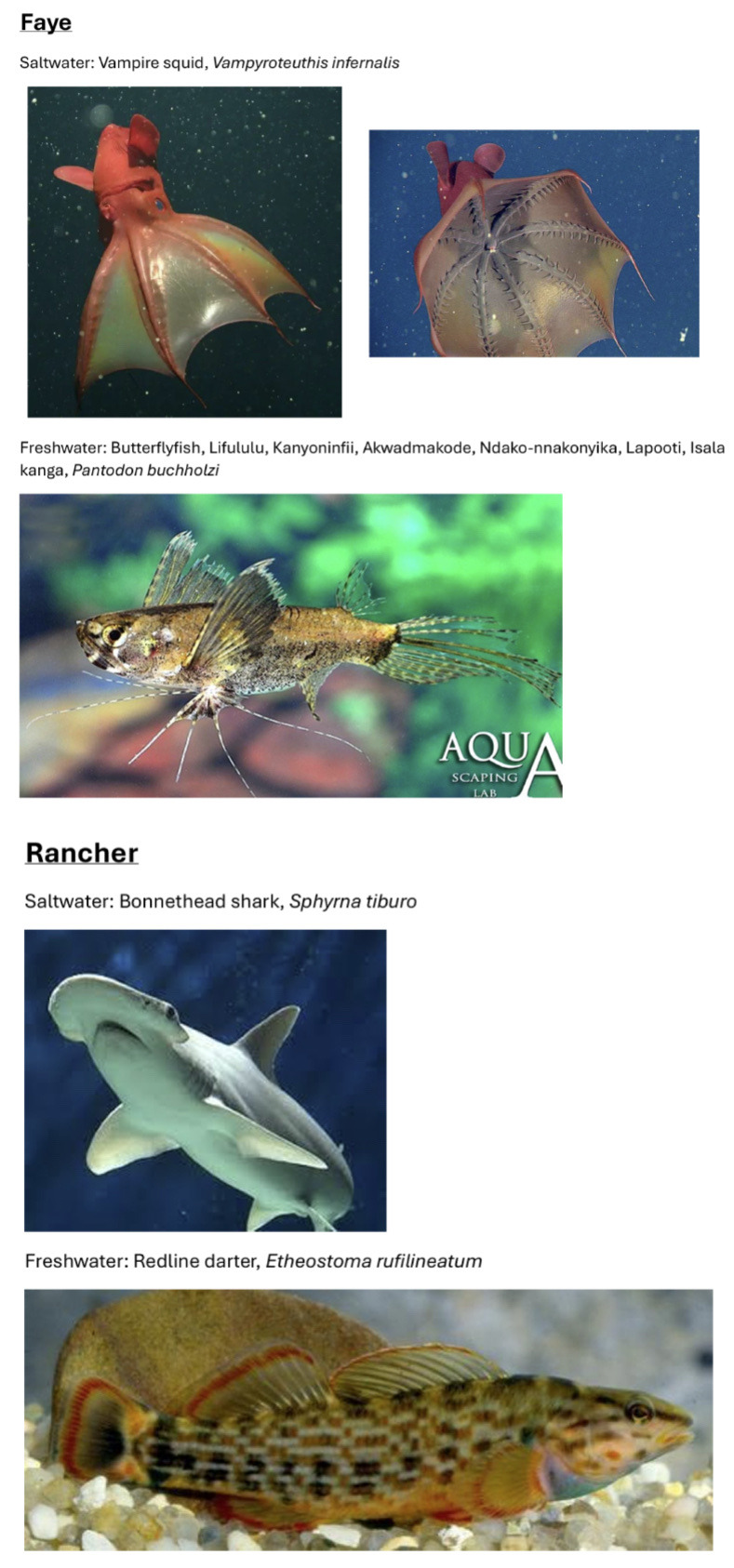
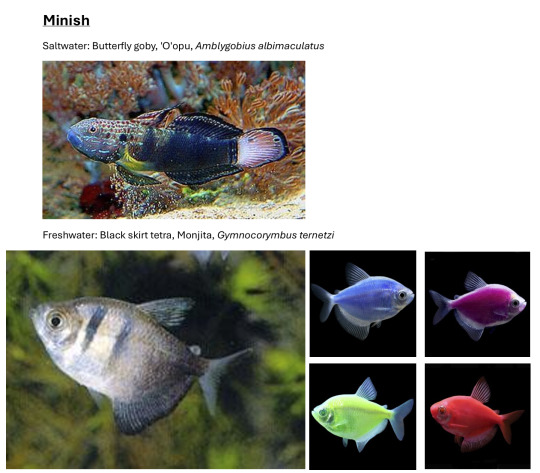
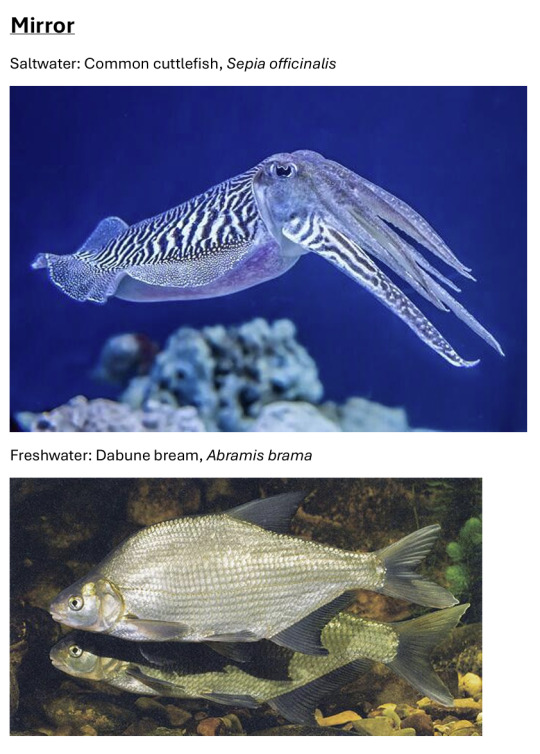
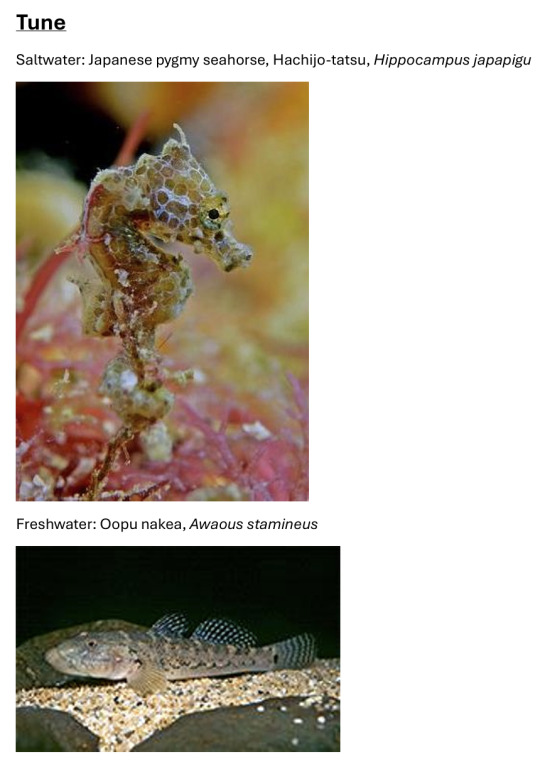
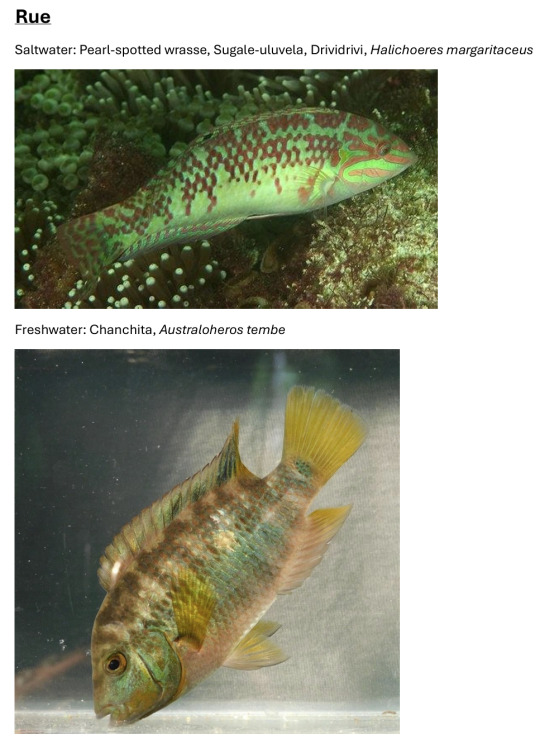
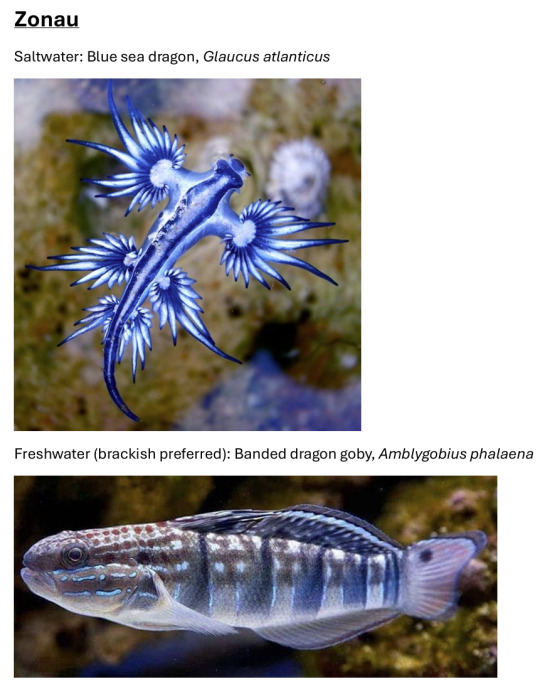
IMAGE ID: Images are the names of each link and then a saltwater fish and a freshwater fish. Each fish has the common name, the common name in the native language of wherever it is found, and then the scientific name. The fish are listed below. Since I am posting this on mobile I only have an English keyboard, so I am only including the common names in the ISO Latin alphabet in the descriptions.
Artisan. Saltwater: Transparent goby, Aphia minuta. Freshwater: Blue discus, Acará disco azul, Symphysodon aequifasciatus.
Engie. Saltwater: Blackspot tuskfish, Marigyan, Mugadyi, Nggalanggari, Choerodon schoeleinii. Freshwater: Doumea reidi.
Eras. Saltwater: Whale shark, Rhincodon typus. Freshwater: Evia barbel, Petropsaro, Barbus euboicus.
Faye. Saltwater: Vampire squid, Vampyroteuthis infernalis. FreshwaterL Butterflyfish, Lifululu, Kanyoninfii, Akwadmakode, Ndako-nnakonyika, Lapooti, Isala kanga, Pantodon buchholzi.
Rancher: Saltwater: Bonnethead shark, Sphyrna tiburo. Freshwater: Redline darter, Etheostoma ruffilineatum.
Minish: Saltwater: Butterfly goby, ‘O’opu, Amblygobius albimaculatus. Freshwater: Black skirt tetra, Monjita, Gymnocorymbus ternetzi.
Mirror. Saltwater: Common cuttlefish, Sepia officinalus. Freshwater: Dabune bream, Abranis brama.
Tune. Saltwater: Japanese pygmy seahorse, Hachijo-tatsu, Hippocampus japapigu. Freshwater: Oopu nakea, Awaous stamineus.
Feathers. Saltwater: Blotchwing flyingfish, Peshk fluturues, Rundinella, Uçan balik, Cheilopogon heterurus. Freshwater: Van loach, Oxynoemacheilus ercisianus.
Rue. Saltwater: Pearl-spotted wrasse, Sugale-uluvela, Drividrivi, Halichoeres margaritaceus. Freshwater: Chanchita, Australoheros tembe.
Wild. Saltwater: Ornate cowfish, Arcana ornata. Freshwater: Blunt-nosed Irish charr, Salvelinus obtusus.
Zonau. Saltwater: Blue sea dragon, Glaucus atlanticus. Freshwater (brackish preferred): Banded dragon goby, Amblygobius phalaena.
/END ID.
15 notes
·
View notes
Text
Loài cá mượn san hô để tách vỏ trai
Cá Choerodon fasciatus sử dụng miệng ném con trai về phía đá san hô, tạo va đập mạnh để làm vỡ vỏ con mồi.
0 notes
Photo

Harlequin Tuskfish - Choerodon fasciatus
Commonly named Harlequin Tuskfish, Choerodon fasciatus (Perciformes - Labridae) is a distinctive fish that seems to have been painted with watercolors in stripes of blue, yellow, red and orange colors. This fish lives in lagoons that are located on the outer edges of reef areas throughout the Indo-Pacific.
Being part of the wrasse family, all Choerodon fasciatus hatch as females (they are protogynous hermaphrodite). As they become adults, loose social groups form. Within each social group, the most dominant female undergoes physiological changes to become a male. Each group consists of one male and multiple females. When the males dies or leaves the second most dominant female becomes the male.
Photo credit: ©Michael McKnight | Locality: Heron Island Queensland, Australia (2014)
#nature#animals#harlequin tuskfish#choerodon fasciatus#choerodon#australia#fauna#underwater#sea life#fish#fishes#perciformes#labridae#zoology#ichthyology#protogynous hermaphrodite#biology#original
61 notes
·
View notes

